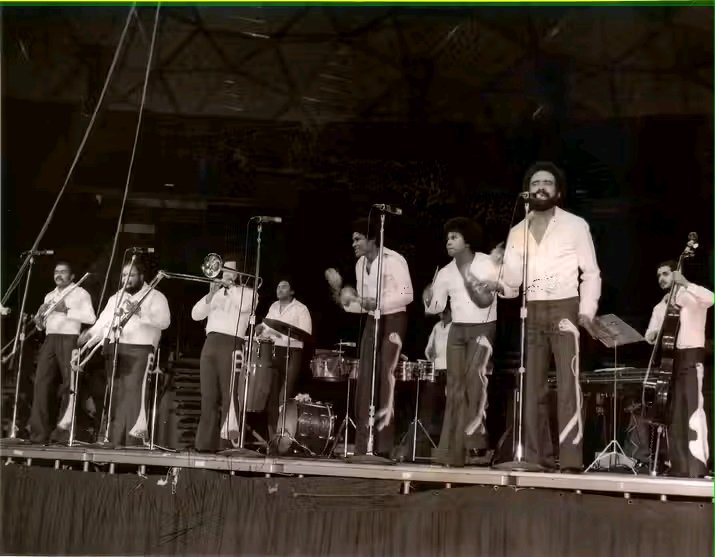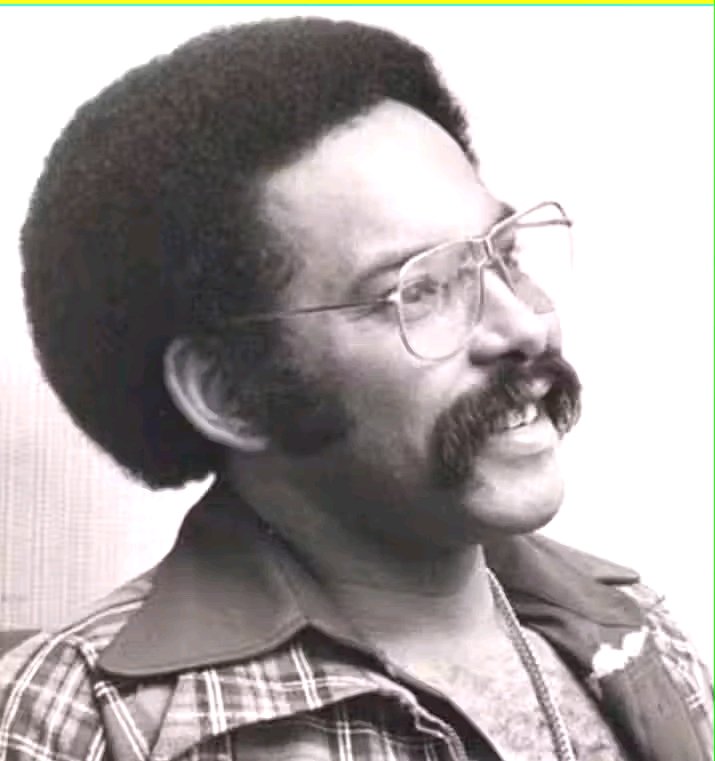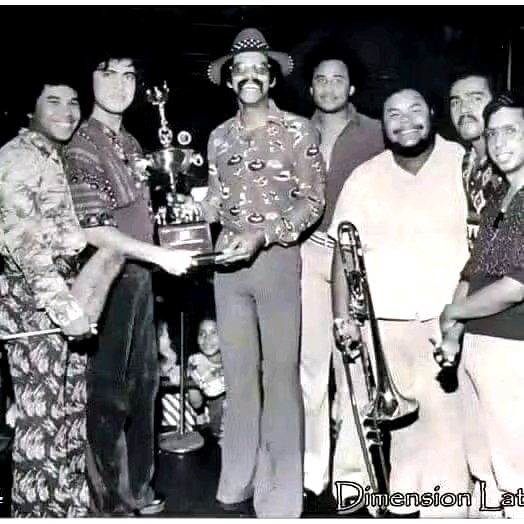Si yo fuera a escribir un libro sobre la salsa, Dimensión Latina no podría faltar. Absolutamente no.

Permítanme explicarles por qué. Esta no es una orquesta más, no es un grupo que pasó por la salsa y ya. Dimensión Latina es el alma misma del género hecho en Venezuela, una máquina de ritmo que le dio vuelta a todo lo que se creía establecido. Si usted piensa que la salsa solo se hacía en Puerto Rico o Nueva York, es porque no ha escuchado con atención lo que estos tipos lograron.

Todo empezó con un taxista llamado Oscar León, un tipo que, entre carrera y carrera, soñaba con montar una orquesta. Junto a Víctor Cuica y César Monge, dos fieras de los metales, armó lo que al principio fue un proyecto más. Pero el destino les tenía guardada una sorpresa. Un pleito entre Cheché Mendoza y el dueño del club La Distinción los puso en el camino correcto. De ahí nació Dimensión Latina, nombre inspirado en The 5th Dimension, pero con una sazón que solo ellos podían darle.
"Sé que tú no quieres que yo a ti te quiera
Siempre tú me esquivas de alguna manera
Si te busco por aquí, me sales por allá
Lo único que yo quiero, no me hagas sufrir más, rumbera".

El 15 de marzo de 1972, en La Guaira, en la casa del pianista Enrique "Culebra" Iriarte, se juntaron por primera vez. Iriarte en el piano, Monge y Rojitas en los trombones, Joseíto Rodríguez en los timbales, Elio Pacheco en las congas y Oscar D’León, el taxista convertido en bajista y cantante. Nadie en ese momento imaginaba que estaban fundando una leyenda. Su debut fue en el mismo lugar donde todo se había desencadenado: La Distinción. Y desde ahí, no hubo vuelta atrás.
"Y después vendrás a mí
Pidiéndome perdón
Pero ya mi corazón
No se acuerda más de ti
Llorarás y llorarás
Sin alguien que te consuele
Así te darás tú cuenta que si te engañan, duele"
Para 1975, ya eran un fenómeno. El disco Dimensión Latina '75 no solo los consagró, sino que les dio el éxito más grande de su carrera: "Llorarás". Lo curioso es que este tema casi no entraba en el álbum, lo pusieron de relleno y terminó siendo el más vendido. Así de impredecible era esta orquesta. Canciones como "Taboga", "Parampampam", "Cañonazo" y "Dolor cobarde" se convirtieron en himnos.
"Por tu mal comportamiento
Te vas a arrepentir
Y en caro tendrás que pagar todo mi sufrimiento".
Pero la historia no termina ahí. Cuando Oscar D’León se fue en 1976, muchos pensaron que era el fin. Error. Llegó Andy Montañez, el puertorriqueño que le inyectó nueva vida. Con él vinieron éxitos como "El Eco de un Tambor", "Linda Minerva" y "Ave María Lola". La gente seguía bailando, la magia seguía intacta.

Detrás de todo esto hay detalles que solo los verdaderos conocedores saben. Que el logo lo dibujó Oscar León con una escuadra. Que en Nueva York no les creían que eran venezolanos porque sonaban demasiado brutales. Que Andy llegó porque Tite Curet Alonso le dijo que esa orquesta era lo mejor que podía pasarle.
"Llorarás y llorarás
Sin alguien que te consuele
Así te darás tú cuenta que si te engañan, duele
Lalala lala lala"
Así que, si alguien me pregunta por qué Dimensión Latina es indispensable en cualquier libro de salsa, mi respuesta es simple: porque sin ellos, la salsa venezolana no sería lo que es. Porque sus canciones no son solo música, son identidad. Porque, cincuenta años después, todavía suenan igual de frescas, igual de poderosas.
Eso, amigos, no es cosa de todos los días. Eso es leyenda.

In English
Dimensión Latina: Soul, Identity, and Legend
If I were to write a book about salsa, Dimensión Latina simply couldn’t be left out. Absolutely not.

Let me tell you why. This isn’t just another orchestra, not just a group that passed through salsa and faded away. Dimensión Latina is the very soul of Venezuelan salsa, a rhythmic machine that turned everything we thought we knew about the genre upside down. If you think salsa was only made in Puerto Rico or New York, you haven’t truly listened to what these guys achieved.

It all started with a taxi driver named Oscar León, a man who, between shifts, dreamed of putting together an orchestra. Alongside Víctor Cuica and César Monge, two beasts on brass, he built what was initially just another project. But fate had a surprise in store for them. A feud between Cheché Mendoza and the owner of the club La Distinción set them on the right path. From there, Dimensión Latina was born—a name inspired by The 5th Dimension, but with a flavor only they could deliver.
"I know you don’t want me to love you / You always avoid me somehow / If I look for you here, you slip away over there / All I ask is that you don’t make me suffer anymore, rumbera."

On March 15, 1972, in La Guaira, at the house of pianist Enrique "Culebra" Iriarte, they gathered for the first time. Iriarte on piano, Monge and Rojitas on trombones, Joseíto Rodríguez on timbales, Elio Pacheco on congas, and Oscar D’León—the taxi driver turned bassist and singer. Nobody at that moment could have imagined they were founding a legend. Their debut was at the very place where it all began: La Distinción. And from there, there was no turning back.
"And later you’ll come to me / Begging for forgiveness / But my heart won’t remember you anymore / You’ll cry and cry / With no one to console you / That’s when you’ll realize—being cheated on hurts."
By 1975, they were a phenomenon. The album Dimensión Latina '75 not only cemented their legacy but gave them the biggest hit of their career: "Llorarás." The funny thing? This track almost didn’t make the album—it was added as filler and ended up being the best-seller. That’s how unpredictable this orchestra was. Songs like "Taboga," "Parampampam," "Cañonazo," and "Dolor cobarde" became anthems.
"For your bad behavior / You’ll regret it / And you’ll pay dearly for all my suffering."
But the story doesn’t end there. When Oscar D’León left in 1976, many thought it was over. Wrong. Enter Andy Montañez, the Puerto Rican who injected new life into the group. With him came hits like "El Eco de un Tambor," "Linda Minerva," and "Ave María Lola." People kept dancing, the magic remained untouched.

Behind all this are details only true connoisseurs know: that the logo was drawn by Oscar León with a ruler; that in New York, people didn’t believe they were Venezuelan because they sounded too explosive; that Andy joined because Tite Curet Alonso told him this orchestra was the best thing that could happen to him.
"You’ll cry and cry / With no one to console you / That’s when you’ll realize—being cheated on hurts / Lalala lala lala..."
So if anyone asks me why Dimensión Latina is essential in any book about salsa, my answer is simple: because without them, Venezuelan salsa wouldn’t be what it is. Because their songs aren’t just music—they’re identity. Because, fifty years later, they still sound just as fresh, just as powerful.
That, my friends, isn’t an everyday thing. That’s legendary.

Qué clase de música! Ya no quedan muchos grupos así.
Oh, muchacho, siii.
Como bailó mi madre con esa música. Ya nada suena igual
You received an upvote ecency
Hasta yo bailé y en realidad me encanta. Un fenómeno cultural. Marcó una generación.
Sin lugar a dudas.
Espero un post sobre tus bailes de juventud con fotos incluidas.
🤣😂
Música vitalicia, que se baila de generación en generación.
Así es amiga mía la calidad no pasa de moda.
Waooo. Me has dado en la vena del gusto. Adoro esa música. Óscar de León es mi ídolo y esa canción, "Llorarás" es mi preferida. Que amanecer tan espectacular. Gracias 🙏😘👏👏👏🌹
Qué placer leer que tu domingo se abre la música, a los recuerdos y a la belleza de esta vida ❤️
¡Agrupación que fue más allá de la dimensión latinoamericana para conquistar al mundo!
¡Bravo!
Absolutamente de acuerdo Maestro, traspasaron el tiempo.
¡Afortunadamente!
Nice one
Thank
You are welcome
Congratulations @marabuzal! You have completed the following achievement on the Hive blockchain And have been rewarded with New badge(s)
Your next target is to reach 900 comments.
You can view your badges on your board and compare yourself to others in the Ranking
If you no longer want to receive notifications, reply to this comment with the word
STOPCheck out our last posts: